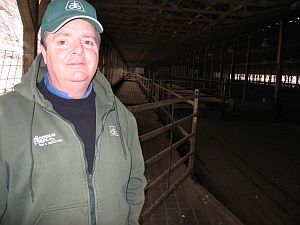Part of the special VPR Series "Hitting Home: The Recession and Vermont"

(Host) Just about everybody is feeling the pinch in this recession. But imagine if your paycheck was cut in half while your expenses stayed the same or even went up.
That’s what’s happened to many dairy farmers. Milk prices have dropped 50 percent in the last few months.
The financial squeeze has forced hard choices on the farm as families struggle to stay in business.
As part of our Hitting Home series, VPR’s John Dillon visited a Franklin County farmer who decided to cut his losses by selling his cows.
(foot steps, barn door opens, then slams. "Empy, empty, empty. Took a long time for me to get used to this feeling.")
(Dillon) Paul Bourbeau’s barns are quiet. The only animals here are a few pigeons in the rafters and a gray barn cat desperate for attention.
Bourbeau pours water in dish.
(Bourbeau) “Cat’s not especially thirsty, much more lonely than thirsty. He’s still got water there…. Got this one barn here that holds 250 cows. Then there was the other barn through there, the bigger barn, holds 400 cows.”
(Dillon) Bourbeau shows off his modern barns and the milking parlor that handles 24 cows at a time. In the milk house, two huge stainless steel tanks stand empty.
(Bourbeau) “This is quiet, this is quiet here for the first time in eight years. Between milker pumps and the milk cooling system, something was on all the time.”
(Dillon) Bourbeau grew up on a dairy farm and has farmed all his working life. But over the Christmas holidays, he accepted a bid to sell his cows through a voluntary herd buy out program run by the nation’s dairy cooperatives.
Sitting at his kitchen counter, Bourbeau explains what led to his decision.
(Bourbeau) “Bonnie and I, my wife and I, were looking at everything that was coming down the pike for 2009. And I play around with spreadsheets a fair amount, and looking at what was going to be happening with our gross income, and what was going to be left over, and what was going to be happening with our net income, it just wasn’t going to work. It just wasn’t going to work.”
(Dillon) Bourbeau rebuilt his barn after a fire eight years ago. His modern facility in St. Albans Town is efficient and houses about 650 cows. But his expenses included feed, labor, electricity and loans to pay for the construction.
If milk prices improve, he wants to start again with a new herd. But after he studied the projections for how far milk prices would fall this year, he came to the decision that he’d lose less money with an empty barn,
(Bourbeau) "It’s the craziest, craziest damn thing. The only way that we were able to even think about staying in dairying long term is if we were not milking cows short term."
(Dillon) Although a dairy farm is an individual operation, farmers really don’t work alone. They depend on – and also support – a network of vendors, veterinarians and other specialists.
Bourbeau’s network includes business colleagues and personal friends. He reads from a letter he wrote them after he and his wife decided to sell the cows.
(Bourbeau) "It’s a tough choice for Bonnie and I as we still love what we’re doing. Dairy farming allows us to interact on a regular basis with some of the finest people that our country has to offer, truly fine men and women dedicated to helping others succeed. The support and advice we received from you will always be treasured. We weren’t ready, but the numbers just weren’t there."
(Dillon) The numbers Bourbeau confronted are being felt statewide. The Agriculture Agency reports that 11 farms went out in January. The state now has about 1,100 dairy farms.
(Allbee) "Prices received by farms is probably the most challenging in 30 years."
(Dillon) Roger Allbee is Secretary of Agriculture. Allbee says prices paid to farmers have dropped to about $10 for 100 pounds of milk, far below what it costs them to produce the product. Allbee says a small surplus of dairy products, including powdered milk, has triggered the sharp drop in farmers’ paychecks.
(Allbee) "We’re impacted in the Northeast basically when there’s too much product in the market even though we’re not over-producing in the Northeast."
(Dillon) The federal pricing system dates back to the Great Depression, and was designed originally to guarantee a regional milk supply. Allbee says the system is broken and needs to be completely overhauled.
Dairy leaders have wrestled with that problem for decades. So in the short term, Allbee hoped farmers would get some relief in the recent stimulus bill. But congressional leaders said no.
(Bourbeau) “If you go back and look at the number of farms in Vermont, you can pretty much pick out when the bad years were.”
(Dillon) Back in St. Albans, Bourdeau’s empty barn and the slight rustle of wind in the rafters is the sound of an industry in crisis.
(Bourbeau) "You know, I can talk about it pretty comfortably today. I’m not going to lie to you, that initial shock and then for the next little while when the cows were gone was a heck of a lot different. My son is really looking forward to the day the animals are back."
(Dillon) Bourbeau is a numbers guy. He says he can’t remember names, but he can do figures in his head. So he offers this number to describe today’s farm economy.
In 1919, when the St. Albans Co-op was founded, members were paid $5 for every 100 pounds of milk sold. Now, 90 years later, they’re expected to get around $10.
For VPR News, I’m John Dillon in St. Albans Town.